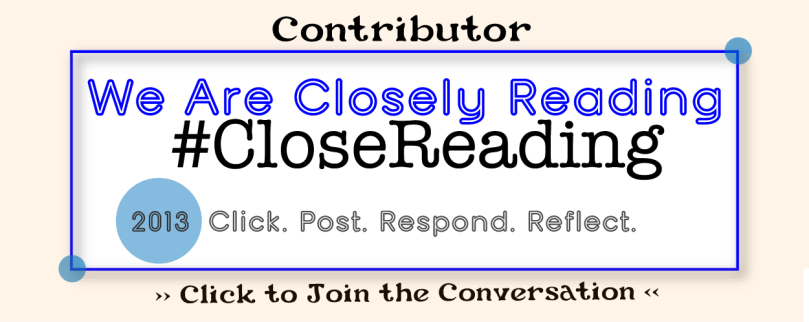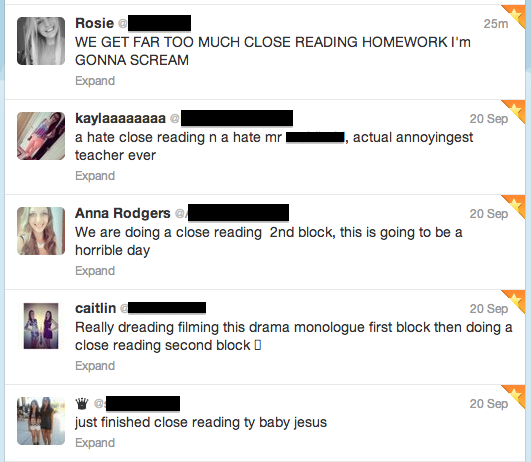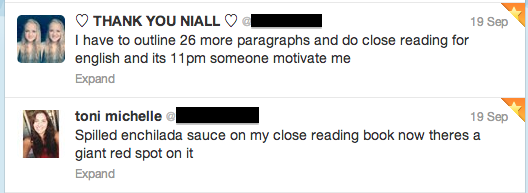Welcome to the last week of our 7-week blog-a-thon on #closereading! Each week educators joined in with comments and links to their own posts, you can visit the Contributors page for a record of the highlights of this inspiring experience. We are still collecting links throughout this final week. Let’s closely read the practice of close reading together!
Also, we look forward to working with many of you in person! My Brookfield, WI workshop “Fall in Love with Close Reading” on December 6 has sold out, however there are still seats available in Amherst, NY on December 9 when Kate and I will be presenting together! Registration can be found here.
Close Reading is Not the Answer…
This Thursday our new book, Falling in Love with Close Reading: Lessons for Analyzing Texts–And Life, is officially released. So Kate and I thought it important to start off this final week of our blog-a-thon letting you know that we think close reading is actually not that important… …at least not in the way some are describing it to be.
- We disagree that close reading is a magic equalizer. We find little evidence that students at a “wide range of reading levels” can read and analyze “demanding text” simply because they are doing so while close reading. Yes, close reading is one way to dig further into texts, but one cannot analyze texts independently that they cannot actually read on their own. Sure, we can do some close teaching, but the goal should be students learn to independently apply close reading skills. (link to Publisher’s Criteria, page 4)
- We do not believe that text dependent questions are teaching. These types of questions may make for good assessment, and we certainly use text-dependent questions at times in our demonstration lessons–after all, we all want students who talk and think through the text. However, lessons built almost entirely around text-dependent questions, without explicit demonstration, do little to pass skills to our students. Especially the students who need it most. Teaching through osmosis is built on chance, not purpose. (link to EngageNY module by Student Achievement Partners)
- We do not believe that curriculum should be built solely around close reading of complex texts. The diversity of our learners’ interests, needs, and strengths is too great to be put all into one practice. Without time for independent practice, for example, there is little opportunity for the practice, data collection and responsive instruction needed to support the growth of readers. (link to EngageNY module by Expeditionary Learning)
- Back in Post #1 of this blog-a-thon, “What Close Reading Isn’t (Or At Least Shouldn’t Be)“, we shared more thinking on what to hold onto and what to avoid (including labeling just anything “close reading”).
…You are the Answer
We think close reading IS important. We think it is as important as any other piece of student-centered, responsive, soul-filling, reading instruction.
Mary Ann Colbert, a master of primary reading instruction and former colleague, once said something that has stuck with me for years: “it’s important that we not only choose our teaching points to match our students, but that we also choose our methods carefully. It’s not just what we teach that makes a difference to kids, its how we choose to teach it.”
I think this idea is at the core of what Kate and I believe about close reading:
- It is a method, a set of skills, for digging deeper into texts, into media, and into our daily lives.
- It is a method, a set of skills, that readers can learn to choose (or not choose) to match their purpose–just as a baker will choose a gentle hand whisk over a powerful electronic mixer at times.
- It is a method, a set of skills, that a teacher can choose (or not choose) to employ to match the needs and strengths of their students.

As Lucy Calkins wrote in The Art of Teaching Writing and echoed in The Art of Teaching Reading:
If our teaching is to be an art, we must draw from all we know, feel, and believe in order to create something beautiful. To teacher well, we do not need more techniques and strategies as much as we need a vision of what is essential. It is not the number of good ideas that turns our work into art, but the selection, balance, and design of those ideas.
We believe close reading is not the sole answer to every need of your students. Instead, we believe your knowledge of all the multi-facets of expert reading instruction, used in response to your students, is what matters.
You–educator, leader, literacy coach, administrator, library/media specialist, parent–are the answer. You are the answer when you continue to grow your kit of tools, when you continue to connect and dream with other educators, when you make decisions because your students’ new horizons.
Beyond Close Reading
As I’m finishing this post I am leafing through the pages of the “References” section in our book. The references are compiled at the end of writing, during production, just as the book is getting ready for it’s final proofread and off to the presses. They appear at the physical end of the book as a list of citations.
Rereading them, now, I am reminded that these texts, these voices, were very much the beginning. Our thinking grew from these educators and authors, their ideas about teaching, learning, and life influenced our own.
…Richard Allington, Katherine Applegate, Nancie Atwell, Dorthothy Barnhouse, Kylene Beers, Katherine and Randy Bomer, Lucy Calkins and the Reading and Writing Project, Eric Carle, Sharon Draper, Doug Fisher, Kelly Gallagher, Stephanie Harvey, John Hattie, Karin Hess, James Howe, Patricia Kain, Ellin Keene, Penny Kittle, Lois Lowry, Donalyn Miller, Tom Newkirk, R.J. Palacio, P. David Pearson, Katie Wood Ray, Louise Rosenblatt, Donna Santman, Jen Serravallo, Jon Steinbeck, Alfred Tatum, Cris Tovani, Lev Vygotsky… I’ve condensed the list here, there are so many others in between and beyond these names. So, many others who are also not directly cited in those final pages.
We hope that when and if you get to those final pages, when you hit that “References” section, that you not turn close the cover too quickly. Instead, let the end become your next beginning.
Continue to study and grow as you always have. Your students need you. We need you.

Your Turn
Which educators, authors, artists, people, have influenced your thinking about teaching, learning and life? When do you find close reading to be necessary and supportive in your instruction and when do you know to bring in another method or skill? This blog-a-thon is about the sharing ideas, we invite you to read the Contributor Page for more posts and information out how to add your own link.
Look for the final official post of this series on Thursday!















